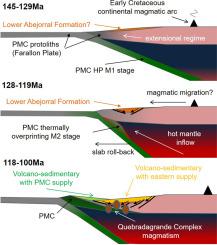Geoscience Frontiers ( IF 8.5 ) Pub Date : 2020-10-22 , DOI: 10.1016/j.gsf.2020.09.019 D.S. Avellaneda-Jiménez , A. Cardona , V. Valencia , S. León , I.F. Blanco-Quintero

|
New field observations and petrological data from Early Cretaceous metamorphic rocks in the Central Cordillera of the Colombian Andes allowed the recognition of thermally overprinted high-pressure rocks derived from oceanic crust protoliths. The obtained metamorphic path suggests that the rocks evolved from blueschist to eclogite facies towards upper amphibolite to high-pressure granulite facies transitional conditions. Eclogite facies conditions, better recorded in mafic protoliths, are revealed by relic lawsonite and phengite, bleb- to worm-like diopside-albite symplectites, as well as garnet core composition. Upper amphibolite to high pressure granulite facies overprinting is supported by coarse-grained brown-colored Ti-rich amphibole, augite, and oligoclase recrystallization, as well as the record of partial melting leucosomes.
Phase equilibria and pressure-temperature (P-T) path modeling suggest initial high-pressure metamorphic conditions M1 yielding 18.2–24.5 kbar and 465–580 °C, followed by upper amphibolite to high pressure granulite facies overprinting stage M2 yielding 6.5–14.2 kbar and 580–720 °C. Retrograde conditions M3 obtained through chlorite thermometry yield temperatures ranging around 286–400 °C at pressures below 6.5–11 kbar. The obtained clockwise P-T path, the garnet zonation pattern revealing a decrease in Xgrs/Xprp related to Mg# increment from core to rim, the presence of partial melting veins, as well as regional constraints, document the modification of the thermal structure of the active subduction zone in Northern Andes during the Early Cretaceous. Such increment of the metamorphic gradient within the subduction interface is associated with slab roll-back geodynamics where hot mantle inflow was triggered. This scenario is also argued by the reported trench-ward magmatic arc migration and multiple extensional basin formation during this period. The presented example constitutes the first report of Cretaceous roll-back-related metamorphism in the Caribbean and Andean realms, representing an additional piece of evidence for a margin-scale extensional event that modified the northwestern border of South America during the Early Cretaceous.
中文翻译:

白垩纪北部安第斯山脉俯冲带的变质梯度修正:热套印高压岩石的记录
来自哥伦比亚安第斯山脉中部山脉早期白垩纪变质岩的新的野外观测和岩石学数据,使人们认识到来自洋壳原石的热套印高压岩石。所获得的变质路径表明,岩石从蓝片岩相向榴辉岩相向上闪石相向高压粒岩相演化。镁铁质原始岩中记录的榴辉岩相条件,由遗迹钠钙榴石和锂铁矿,从泡状到蠕虫状的透辉石-安比妥共沸石和石榴石核心成分揭示。上层角砾岩至高压粒岩相的叠印受粗粒棕色富钛闪石,闪石和寡糖酶的重结晶以及部分融化的脂质体的记录支持。
相平衡和压力-温度(PT)路径模型表明,初始高压变质条件M1产生18.2–24.5 kbar和465–580°C,其次是上闪石至高压花岗石相叠印阶段M2产生6.5–14.2 kbar和580 –720°C。通过亚氯酸盐测温获得的逆行条件M3在低于6.5-11 kbar的压力下产生的温度范围约为286-400°C。所获得的顺时针PT路径,石榴石分区模式显示X grs / X prp减小与Mg#从岩心到边缘的Mg#增加有关,部分熔融脉的存在以及区域性约束,都记录了早白垩纪北安第斯山脉活跃俯冲带热结构的变化。俯冲界面内变质梯度的这种增加与板块回滚地球动力学有关,在该板块回滚地球动力学中触发了热地幔流入。在此期间,据报道的向沟槽的岩浆弧迁移和多个伸展盆地的形成也证明了这种情况。所提出的例子构成了加勒比海和安第斯山脉白垩纪回滚相关变质作用的首次报道,代表了边缘尺度扩展事件的另一条证据,该事件在白垩纪早期改变了南美的西北边界。











































 京公网安备 11010802027423号
京公网安备 11010802027423号